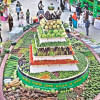If you've been to Wise Ghat very recently, you'll be familiar with the scene of watermelons being unloaded from boats. With summer here, watermelons have arrived at the perfect time. Now that the markets are overflowing with fresh watermelons, it's the best time to enjoy this refreshing fruit after a long day out!
The sight of fresh, vibrant watermelons piled high on boats and nearby stalls create a beautiful contrast against the bustling streets of Old Dhaka. The markets are alive with the colours of summer.
It was around 2 PM when labourers were unloading watermelons from boats. Some were still working under the hot sun, while others took a break after hours of hard labour. We approached Md Nesar, a labourer, resting under the shade, to learn more about their contribution.
"We are labourers, and we unload watermelons using bamboo baskets. For each watermelon, we earn Tk 3 to Tk 3.5. We carry them in batches of 8 to 10 and unload them at the nearby stores," Nesar shares.
When asked about the supply this year, he shares, "There are only a few boats now, as you can see here, but soon, the number of boats will increase, and so will the watermelons."
But it's not just watermelons that arrive at the riverbank. "Fruits like lychees, pineapples, guavas, dragon fruits, papayas, and mangoes also arrive by boats. We work all year round, not just during watermelon season," explains Limon, another labourer.
We found Hasib, the Sardar — someone who arranges labourers for unloading fruits, giving orders to his men to work properly. He himself started as a labourer, and has been in the Sardar profession for nearly 8 years. His family has been in the business for about 40 years, starting with his grandfather.
You might wonder how watermelons are distributed fairly, when they come in different sizes. According to their terminology, there are four size categories, each priced differently. The largest is called 'Mati,' followed by 'Majhla,' 'Tin Number,' and the smallest, 'Kat.'
"To keep things simple, they are often referred to as sizes 1, 2, 3 and 4. There is a designated man on the boat whose job is to ensure the watermelons are distributed properly," Hasib explains.
When asked how they keep track of the number of watermelons each labourer unloads, Hasib describes, "There's a simple system. Every time a labourer carries watermelons from the boat, the person assigned hands him a stick with signs sealed on it. The sticks help keep count of how many watermelons he has unloaded."
So, where do all the watermelons come from? The watermelons come from Rangabali, locally known as the capital of watermelons, as well as from Galachipa, Char Fasson, and Bhola. They travel in large boats from Barishal, Bhola, or Patuakhali, and are unloaded at Wise Ghat, Hajiganj, or Fatullah before the Asr prayer call. Some watermelons also arrive by truck and are distributed to different wholesale markets across the city.
"There are other wholesale watermelon markets apart from the one here. Karwan Bazar, Hajiganj, and Jatrabari also have their wholesale markets," shares Hasib.
Sardar Hasib also introduced us to deeper insights into how this trade operates. Though the process may seem simple, it involves people with multiple responsibilities. There are two main roles: 'Byapari' and 'Aratdar.'
The Aratdar is a wholesaler who provides loans to the Byapari. The Byapari then manages the entire watermelon cultivation process and sells the produce with a commission. "This means that a single watermelon supports the livelihoods of farmers, byaparis, aratdars, sardars, labourers and many others," Hasib explains.
The wholesale market, standing on the other side of the road from Wise Ghat, is known as Alf Sani (R.A) Market, located at 7 Ahsan Ullah Road. From here, watermelon supplies spread across the entire city. Jitu, an Aratdar, explains, "We sell in bulk — either per 100 or per 150 watermelons, depending on the production. It can start from Tk 20 and go up to Tk 300 or more per piece."
The watermelon season lasts for almost four months. During this time, thousands of people work hard to ensure that fresh watermelons reach markets and consumers. The trade is more than just buying and selling — it is a long-standing tradition that supports many families. As the season continues, the river will get busier, boats will bring in more loads — this is the only hope of all the people involved.






Comments